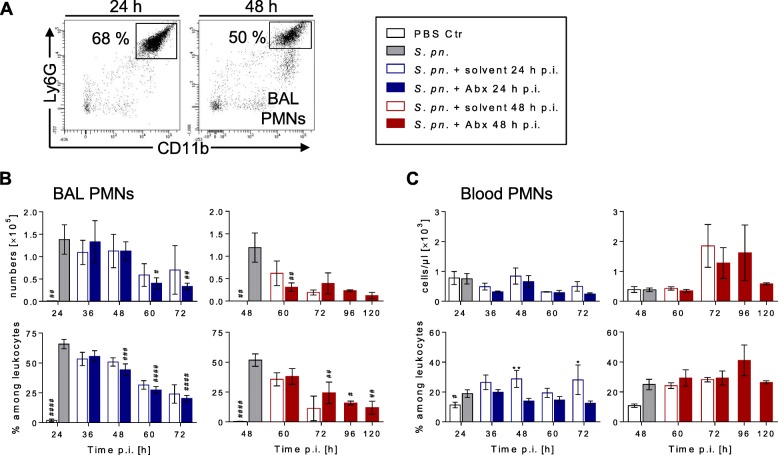Fig. 2.
Antibiotic therapy has no impact on alveolar neutrophil recruitment. Mice were infected with S. pneumoniae and assigned equally to groups and analysis time points (ntotal = 9 per time point). Starting 24 h or 48 h p.i., intervention groups were treated with ampicillin. As controls, mice were sham infected (PBS; ntotal = 7 per time point) or treated with solvent (0.9% NaCl). Mice surviving until designated analysis time point were sacrificed for BAL and blood sampling (number analyzed per time point presented in Additional file 1: Table S1). a Representative dot blots illustrating gating of innate BAL PMN populations at 24 h and 48 h p.i. b Numbers and frequencies of PMNs in BAL of mice analyzed at indicated time points p.i., quantified by flow cytometry. c Numbers and frequencies of PMNs measured in EDTA-blood by Scil Vet abc hematology analysis of respective mice. b, c Results pooled from three independent experiments per time point. Mean ± SEM. Two-way ANOVA/Sidak’s multiple comparisons test for comparison of ampicillin versus solvent treatment. One-way ANOVA/Dunnett’s multiple comparisons test for comparison to S. pneumoniae-infected mice at therapy start. *Significant difference between groups at time point, #significant difference from therapy start: */#p < 0.05, **/##p < 0.01, ###p < 0.001 and ####p < 0.0001. Abx antibiotics, BAL bronchoalveolar lavage, Ctr control, PBS phosphate buffered saline, p.i. post infection, PMN polymorphonuclear leukocyte, S. pn. Streptococcus pneumoniae

